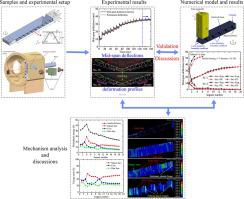当前位置:
X-MOL 学术
›
Int. J. Solids Struct.
›
论文详情
Our official English website, www.x-mol.net, welcomes your feedback! (Note: you will need to create a separate account there.)
Shakedown of metallic sandwich beams when subjected to repeated impact loadings
International Journal of Solids and Structures ( IF 3.6 ) Pub Date : 2024-03-28 , DOI: 10.1016/j.ijsolstr.2024.112793 Zengshen Yue , Zhouyu Han , Xin Wang , Runpei Yu , Yilin Qu , Pengfei Wang , Zhenyu Zhao , Qiancheng Zhang , Tian Jian Lu
International Journal of Solids and Structures ( IF 3.6 ) Pub Date : 2024-03-28 , DOI: 10.1016/j.ijsolstr.2024.112793 Zengshen Yue , Zhouyu Han , Xin Wang , Runpei Yu , Yilin Qu , Pengfei Wang , Zhenyu Zhao , Qiancheng Zhang , Tian Jian Lu

|
When a monolithic metallic beam/plate subjected to repeated dynamic loadings with fixed impact level experiences elastoplastic deformation, its measurable deformations may cease to develop for further repetitions of the same dynamic load: this phenomenon was referred to as “pseudo-shakedown” in previous studies (). Would pseudo-shakedown occur in a metallic sandwich structure under repeated shock loadings remains elusive. A combined experimental and numerical study was carried out to explore whether dynamic shakedown could occur in all-metallic ultralightweight corrugated core sandwich beams. For repeated impact tests, the sandwich beams were fabricated via the sequential process of cutting-stamping-vacuum brazing. When subjected to repeated impact loads (achieved via aluminum foam projectiles launched from a light gas gun), the dynamic responses of each sandwich specimen - including structural evolutions, beam deflections, and deformation/failure modes - were measured. Experimental results revealed that, depending upon the level of impact momentum applied to the sandwich beam, either dynamic shakedown or progressive failure could occur. The method of finite elements (FE) was subsequently employed to simulate the repeated shock tests, which was validated against experimental measurements, with good agreement achieved. To explore the physical mechanisms underlying the observed dynamic shakedown, the FE results of final plastic energy and effective plastic strain distribution in the sandwich beam were extracted and analyzed. When shakedown occurred, the measurable permanent deformation of the sandwich beam kept a relatively stable state, but its plastic energy remained positive, which is different from its monolithic beam/plate counterpart (i.e., plastic energy dropping to zero during dynamic shakedown). Such difference is mainly attributed to stress concentration occurring at the connecting joint points between the corrugated core and face sheets of sandwich and clamped endings, which produces plastic deformations that are difficult to reflect in overall large deformations of the beam. Consequently, the dynamic shakedown of metallic corrugated core sandwich beam captured in this study appears to be inexhaustive and hence may be termed as the “apparent pseudo-shakedown” (with danger lurking in the welding joints as well as clamped endings). Finally, based on a simplified bi-linear hardening constitutive law, the mechanisms underlying the dynamic shakedown of sandwich beam were further discussed from a purely base material point of view.
中文翻译:

承受重复冲击载荷时金属夹层梁的安定
当单调金属梁/板承受固定冲击水平的重复动态载荷而经历弹塑性变形时,其可测量的变形可能会停止发展以进一步重复相同的动态载荷:这种现象在以前的研究中被称为“伪安定” ()。在重复冲击载荷下,金属夹层结构是否会发生伪安定仍然难以捉摸。进行了实验和数值相结合的研究,以探讨全金属超轻波纹芯夹层梁是否会发生动态安定。为了进行重复冲击试验,夹层梁是通过切割-冲压-真空钎焊的顺序工艺制造的。当受到重复的冲击载荷(通过轻气枪发射的泡沫铝弹丸实现)时,测量了每个夹层样本的动态响应,包括结构演变、梁偏转和变形/失效模式。实验结果表明,根据施加在夹层梁上的冲击动量水平,可能会发生动态安定或渐进失效。随后采用有限元(FE)方法来模拟重复的冲击试验,并根据实验测量进行验证,取得了良好的一致性。为了探索所观察到的动态安定背后的物理机制,提取并分析了夹层梁中最终塑性能和有效塑性应变分布的有限元结果。当安定发生时,夹层梁的可测量永久变形保持相对稳定的状态,但其塑性能仍然为正,这与整体梁/板对应物不同(即动态安定期间塑性能降至零)。这种差异主要是由于夹芯端部和夹紧端部的波纹芯材与面板连接点处出现应力集中,产生塑性变形,而这种塑性变形很难反映在梁的整体大变形中。因此,本研究中捕获的金属波纹芯夹层梁的动态安定似乎并不详尽,因此可以被称为“明显的伪安定”(焊接接头和夹紧端部潜伏着危险)。最后,基于简化的双线性硬化本构定律,从纯基材的角度进一步讨论了夹层梁动态稳定的机理。
更新日期:2024-03-28
中文翻译:

承受重复冲击载荷时金属夹层梁的安定
当单调金属梁/板承受固定冲击水平的重复动态载荷而经历弹塑性变形时,其可测量的变形可能会停止发展以进一步重复相同的动态载荷:这种现象在以前的研究中被称为“伪安定” ()。在重复冲击载荷下,金属夹层结构是否会发生伪安定仍然难以捉摸。进行了实验和数值相结合的研究,以探讨全金属超轻波纹芯夹层梁是否会发生动态安定。为了进行重复冲击试验,夹层梁是通过切割-冲压-真空钎焊的顺序工艺制造的。当受到重复的冲击载荷(通过轻气枪发射的泡沫铝弹丸实现)时,测量了每个夹层样本的动态响应,包括结构演变、梁偏转和变形/失效模式。实验结果表明,根据施加在夹层梁上的冲击动量水平,可能会发生动态安定或渐进失效。随后采用有限元(FE)方法来模拟重复的冲击试验,并根据实验测量进行验证,取得了良好的一致性。为了探索所观察到的动态安定背后的物理机制,提取并分析了夹层梁中最终塑性能和有效塑性应变分布的有限元结果。当安定发生时,夹层梁的可测量永久变形保持相对稳定的状态,但其塑性能仍然为正,这与整体梁/板对应物不同(即动态安定期间塑性能降至零)。这种差异主要是由于夹芯端部和夹紧端部的波纹芯材与面板连接点处出现应力集中,产生塑性变形,而这种塑性变形很难反映在梁的整体大变形中。因此,本研究中捕获的金属波纹芯夹层梁的动态安定似乎并不详尽,因此可以被称为“明显的伪安定”(焊接接头和夹紧端部潜伏着危险)。最后,基于简化的双线性硬化本构定律,从纯基材的角度进一步讨论了夹层梁动态稳定的机理。



























 京公网安备 11010802027423号
京公网安备 11010802027423号